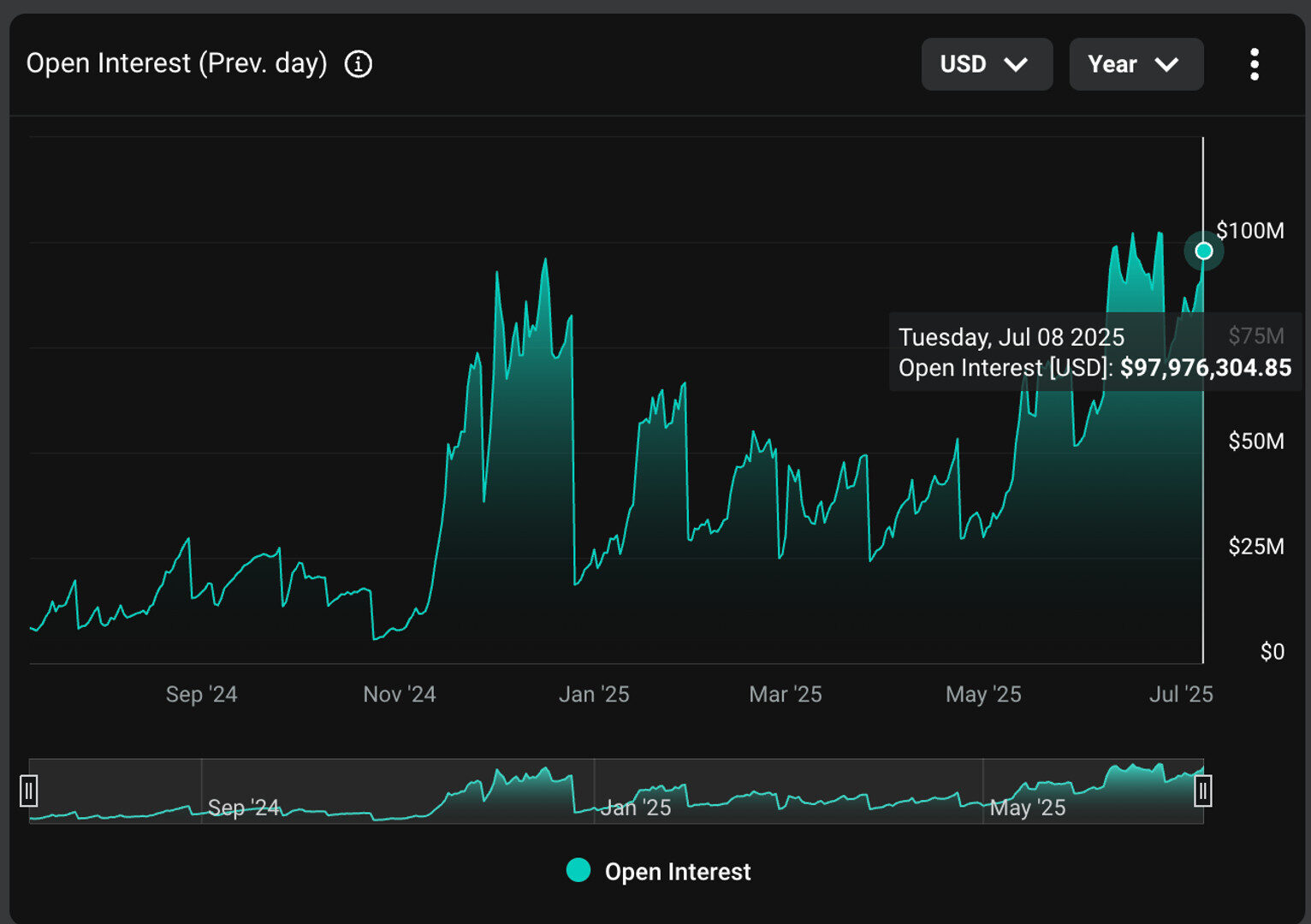BTC
$111,299.27
+
1.71%
ETH
$2,772.76
+
5.32%
USDT
$1.0004
+
0.03%
XRP
$2.4366
+
2.27%
BNB
$668.60
+
1.27%
SOL
$156.44
+
2.11%
USDC
$0.9999
+
0.01%
TRX
$0.2909
+
1.00%
DOGE
$0.1797
+
4.30%
ADA
$0.6256
+
3.06%
HYPE
$41.74
+
5.70%
SUI
$3.2294
+
9.95%
BCH
$504.89
+
0.18%
WBT
$46.25
+
1.52%
LINK
$14.33
+
2.17%
XLM
$0.2904
–
0.23%
LEO
$8.9691
–
0.64%
AVAX
$19.47
+
5.23%
HBAR
$0.1770
+
5.93%
SHIB
$0.0₄1242
+
3.18%
By Omkar Godbole, CD Analytics|Edited by Sheldon Reback
Jul 10, 2025, 2:21 p.m.

- The notional open interest in XRP options on Deribit has surged 38% in two weeks
- XRP’s implied volatility is higher than other major tokens like bitcoin and ether, attracting yield hunters and boosting options popularity.
- Market sentiment is bullish, with positive risk reversals indicating a preference for call options.
The dollar value locked in open XRP options contracts listed on Deribit is rapidly climbing to a record as the token’s high implied volatility draws yield hunters.
The so-called notional open interest (OI) has risen to nearly $98 million from $71 million since the June 27 quarterly expiry, a solid 38% rise in two weeks. It is now nearing the June 24 record of $102.3 million, according to data source Deribit Metrics. In contract terms, the OI has increased by 26% to 42,414. (The contract multiplier for XRP on Deribit is 1,000 XRP).
STORY CONTINUES BELOW
Behind the increase is the token’s implied volatility, a measure of expected price swings over a specific period. XRP’s is higher than bitcoin
, ether
and solana
, according to Lin Chen, Deribit’s head of Asia business development.
“XRP has delivered an annual return of over 300% over the past 12 months,” Chen told CoinDesk. “Its options have also gained significant popularity, reflected in the highest implied volatility among major tokens — indicating strong investor demand.”
One way traders are making gains is by selling cash-secured puts, Chen said. Writing a put option — agreeing to buy the asset at a set price — is akin to selling insurance against price drops in return for a premium, which represents the seller’s return.
Traders typically write options against holdings in the spot market or in a “cash-secured” way when the implied volatility is high. The higher the volatility, the costlier the options and vice versa. The cash-secured version involves holding enough stablecoins to ensure the underlying asset can be bought if the price slides and the put buyer decides to exercise their right to sell the asset at the predetermined price.
As of the time of writing, the 25-delta risk reversals were positive, indicating a bias toward call options, or bullish bets, according to data tracked by Amberdata.
The 25-delta risk reversal is a strategy that comprises a long put position and a short call option (or vice versa) with a 25% delta, meaning both options are relatively far from the underlying asset’s current market price.
The pricing for risk reversals across tenors helps identify market sentiment, with positive values representing a relative richness of calls and negative values indicating a downside bias. At press time, short-term XRP risk reversals and those tied to August and September expiries were positive.

Furthermore, more than 30 million calls were open, outstripping 11.92 million puts, giving a put-call ratio of 0.39, also a sign of bullish sentiment in the market.
Disclaimer: Parts of this article were generated with the assistance from AI tools and reviewed by our editorial team to ensure accuracy and adherence to our standards. For more information, see CoinDesk’s full AI Policy.
Omkar Godbole is a Co-Managing Editor on CoinDesk’s Markets team based in Mumbai, holds a masters degree in Finance and a Chartered Market Technician (CMT) member. Omkar previously worked at FXStreet, writing research on currency markets and as fundamental analyst at currency and commodities desk at Mumbai-based brokerage houses. Omkar holds small amounts of bitcoin, ether, BitTorrent, tron and dot.
CoinDesk Analytics is CoinDesk’s AI-powered tool that, with the help of human reporters, generates market data analysis, price movement reports, and financial content focused on cryptocurrency and blockchain markets.
All content produced by CoinDesk Analytics is undergoes human editing by CoinDesk’s editorial team before publication. The tool synthesizes market data and information from CoinDesk Data and other sources to create timely market reports, with all external sources clearly attributed within each article.
CoinDesk Analytics operates under CoinDesk’s AI content guidelines, which prioritize accuracy, transparency, and editorial oversight. Learn more about CoinDesk’s approach to AI-generated content in our AI policy.
















